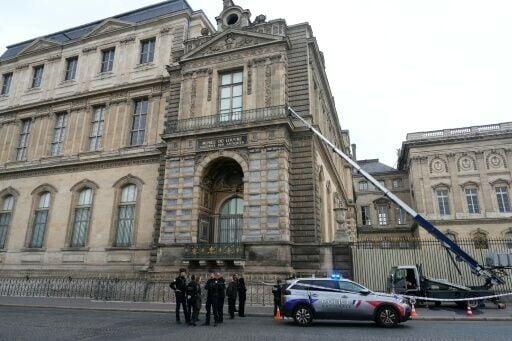The mystery surrounding the “mammoth” heist at the Louvre Museum in France continues. Five days have passed since the cinematic break-in, but the thieves who managed to steal jewelry worth 88 million euros last Sunday remain at large. Authorities are focusing on the traces left behind by the burglars, with over 150 DNA samples, fingerprints, and other evidence already collected from the crime scene.
As explained to the newspaper Ouest-France, analysis of these findings “requires time, even though they have been given absolute priority by the laboratories“. The first results expected “in the coming days” may open new investigative leads, especially “if the perpetrators are already registered in the police database“.
The prosecutor also noted that the camera system allowed authorities to track the perpetrators’ escape route “through Paris and neighboring districts“. Additionally, they are utilizing “footage from public and private cameras – on highways, banks, and businesses“.
Louvre museum heist: New headache for Macron
According to government spokesperson Maud Brégeon, the Élysée has requested proposals for new surveillance cameras, enhanced detection systems, and a central security control center within a week. However, the cost is enormous. Sébastien Lecornu’s government is already struggling with fiscal constraints and billions in defense and industrial investments.
“Financial promises for the Louvre must be kept“, emphasizes Valérie Beau, employee representative. “The museum is 68% self-funded. The state can no longer impose new cuts“.
🇫🇷🚨BREAKING: Footage of the heist targeting the Louvre in Paris has now been released.
This is the first time we can see actual video of the “heist of the century.”
Here, the thieves escape on a truck-mounted lift before fleeing on a scooter. pic.twitter.com/LsCrAFeziW
— Remix News & Views (@RMXnews) October 22, 2025
Authorities continue investigations
The investigation, conducted for “theft by organized gang“, now focuses on locating the four thieves who escaped with eight pieces from the French royal jewelry collection, worth a total of 88 million euros.
Bécot emphasized her intention “to arrest the perpetrators as quickly as possible, so that the jewelry can be recovered before the precious stones are removed or the metals melted down“.
Meanwhile, she estimated that the massive publicity the case received “leaves a small hope that the perpetrators will not dare to move easily with the jewelry in their possession“.
“I want to remain optimistic“, concluded the Paris prosecutor.
The new video
Four days after the cinematic heist à la “Arsène Lupin” the first images from the perpetrators’ escape were released. In these images we see the two perpetrators descending the ladder inside the lift mechanism. Indeed, one of them is wearing a helmet. Two accomplices with scooters were waiting for them on the street.
The president and director of the Louvre, Laurence des Cars, in her first statements after the incident, acknowledged that there are serious gaps in the museum’s security measures, emphasizing before French senators that the closed-circuit television systems around the Louvre are weak and “outdated“.
“The only camera monitoring the outer wall of the Louvre, which they broke through, was turned away from the first-floor balcony that led to the Apollo Gallery where the jewelry was housed“, she noted. “We failed these jewels“, she also said, adding that no one was protected from the “brutal criminals – not even the Louvre“.
The heist has caused a political storm in Paris, with calls for resignations.
First in the crosshairs, Culture Minister Rachida Dati, who acknowledged administrative errors but spoke of “40 years of neglect and indifference“. “We prioritized visitor safety, not artwork security“, she said.
Louvre director Laurence des Cars also faced intense pressure in the Senate, where she defended her management saying: “Despite our efforts, we were defeated“. She denied allegations of mismanagement and “luxury projects” and emphasized that the museum is in a “generalized state of deterioration“.




